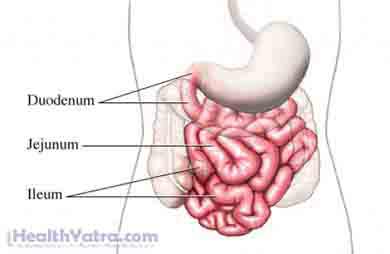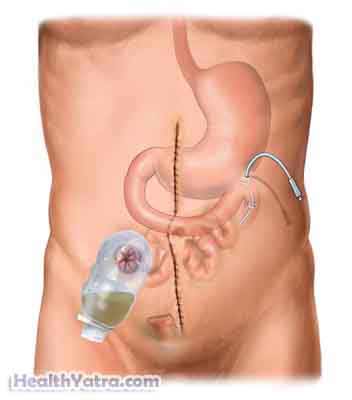Definition
A small bowel resection is the removal of part of the small intestine. The small intestine includes the duodenum, jejunum, and ileum. The surgery can be done through an open incision or using smaller incisions.

Reasons for Procedure
This procedure may be done to treat the following conditions:
- Bleeding, infection, or ulcers in the small intestines
- Cancer
- Precancerous polyps
- Crohn’s disease
- Intestinal blockage
- Injury
Possible Complications
Complications are rare, but no procedure is completely free of risk. If you are planning to have a resection, your doctor will review a list of possible complications, which may include:
- Excessive bleeding
- Infection
- Blockage of the intestine caused by scar tissue
- Hernia formation at the incision site
Factors that may increase the risk of complications include:
- Smoking
- Previous abdominal surgery
- Malnutrition
- Chronic illness
- Drug use
What to Expect
Prior to Procedure
Your doctor may do the following:
- Physical exam
- Blood and urine tests
- X-rays of the chest and abdomen
- CT scan of the abdomen
Leading up to your procedure:
- Talk to your doctor about your medicines. You may be asked to stop taking some medicines up to one week before the procedure, like:
- Aspirin or other anti-inflammatory drugs
- Blood thinners
- Take medicines as recommended by your doctor. This may include antibiotics.
- Your intestines should be cleaned out for the surgery. During the week before surgery, eat high-fiber foods and drink plenty of water. This will encourage bowel movements. Other cleansing methods may also be recommended, including enemas, laxatives, and a clear-liquid diet. You may be asked to drink a large container of solution that helps with the complete emptying of your intestines.
- Begin fasting as directed by your doctor.
Anesthesia
General anesthesia will be given. You will be asleep.
Description of Procedure
The procedure may be done with one of two methods:
- Traditional open incision—An incision will be made into the abdomen in the area of the diseased intestine.
- Laparoscopic technique—A few small incisions will be made in the abdomen. Carbon dioxide gas will be pumped into the abdomen through an incision. A laparoscope, which is a thin tube with a small camera on the end, will be inserted through the incisions. Special tools will also be inserted through these incisions. The laparoscope sends a view of the interior of the abdomen to a video monitor.
In either type of surgery, the small intestine will be clamped above and below the diseased section. This section will be cut free and removed.
If there is enough healthy intestine left, the free ends of the intestine may be joined together. Otherwise, a permanent or temporary ileostomy is created. An ileostomy is an opening called a stoma in the abdomen. The end of the small intestine closest to the stomach is attached to the opening. This allows intestinal contents to drain into a sealed pouch on the outside of the body. If a temporary ileostomy is created, another operation will be necessary several months later to reverse it.

The abdomen incisions will be closed with stitches.
How Long Will It Take?
About 1-4 hours
How Much Will It Hurt?
Anesthesia prevents pain during the procedure. Talk to your doctor about medicine to help manage the pain in recovery.
Average Hospital Stay
The usual length of stay is 5-7 days. Your doctor may choose to keep you longer if complications arise.
Post-procedure Care
At the Hospital
A catheter will be placed in your bladder before surgery. You will also have a nasogastric tube. This is a small tube that goes in through your nose and down into your stomach. The tube may be used to drain fluids from your stomach or to help deliver food to your stomach. The catheter and tube will remain until you are able to eat and go to the bathroom normally.
At Home
When you return home, do the following to help ensure a smooth recovery:
- Your doctor will tell you when you can resume your normal activities.
- Check with you doctor about doing any heavy lifting or tiring activities.
- Do not drive unless your doctor has given you permission to do so.
- Ask your doctor about when it is safe to shower, bathe, or soak in water.
- Exercise your legs while in bed to prevent blood clots.
- If you go home with an ileostomy, you will receive instructions on how to change the bag and maintain personal hygiene.
- Be sure to follow your doctor’s instructions.
Call Your Doctor
After you leave the hospital, contact your doctor if any of the following occurs:
- Signs of infection, including fever and chills
- Any redness, swelling, bleeding, or drainage from the incision site
- Your bandage becomes soaked with blood
- Stitches or staples come apart
- Nausea and/or vomiting that you cannot control with the medicines you were given after surgery, or which persist for more than two days after discharge from the hospital
- Persistent abdominal pain or bloating
- Constipation or diarrhea
- Rectal bleeding or tarry-colored stools
- Pain that you cannot control with the medicines you have been given
- Cough, shortness of breath, or chest pain
- Pain, burning, urgency, frequency of urination, or persistent blood in the urine
- New symptoms
In case of an emergency, call for medical help right away.
